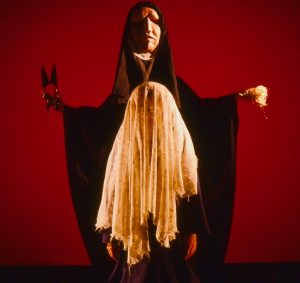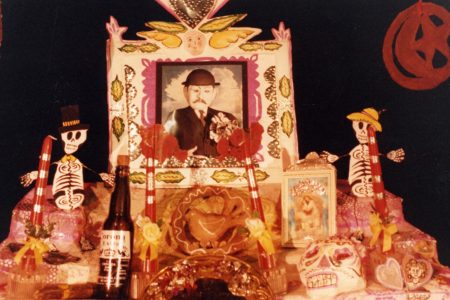1990: The Wish
The 1990 touring show, The Wish, was yet another uncomfortable story. Like The Wheel it was based on a film that I had seen, though this time I did at least manage to catch the whole thing. It was an Indian movie in which a married but childless woman makes an offering at a shrine wishing for a child, though secretly she fears that her husband is impotent. The shrine happens to be right next to the village well. The villagers are experiencing constant failures of the water supplied by the well. A drought is threatened. Then a mysterious stranger arrives, and he persuades everyone that a smart pump mechanism will solve their water problems. Which it does, and they herald him as a saviour, lavishing gifts on him.
However he begins to charge for access to the water, and in this way he slowly gains control over the village. The touring set included a masterpiece of onstage plumbing created by Tim Bender, who created a working water-well. This contraption of pipes and pumps had to be fitted to the well as part of the narrative of the play. It was then used to pump water into various bottles and buckets as necessary. Part of the set can be seen in the photograph above.
1991: The Flood
The Flood (above) in 1991 was the first show in which I didn’t perform at all, and I was able to direct with my full attention. I decided on a poetic and disjointed story-line, based loosely on bible stories. It was an odd show; one of my personal favourites. There were four scenes. In the first, the Warning, a Carpenter is told of a forthcoming deluge by a stove-pipe hatted delegation. They try and explain the seriousness of the situation. But he refuses to listen to his warnings, and goes back to bed. In the second, the Search, the Carpenter sees the drowning people. He builds a boat to find Rain. After an epic journey he finds her, in her Forest. In the third scene, animals appear out of the Forest, fleeing from the rising waters, and he ends up with a Noah’s Ark-like cargo. The animals squabble, then begin to fight, and they sink the boat. Finally, in The Story of Hope, or The Rumour, crowds of figures appear, seeming to move at random. Then a small boat appears, holding a new-born baby. The crowd of figures gradually begin to move together. They look one way, and then the other. Finally they gently blow and sway together… their breath slowly blows the child to safety. The music for this show, by John Moreton and Keith Bray was particularly memorable. I chose the track ‘Sailing Away’ as music to be played at my father’s funeral.
Motorised touring
Another important decision we took at this time was to integrate our tours. Once the summer horse-drawn tour ended we continued to tour the same show, but now using our van. The abortive experiment with the truck as part of The Wish tour was a pre-cursor to this. But in abandoning the attempt at sleeping in vehicles, the Travelodge necessarily became a friend. In the case of The Flood it meant the tour could continue until the end of November, and play as many as 60 venues.The motorised tour of The Flood involved a further 34 performances once the horses had been put back in their field. This routine then became the norm for the company.
FLOOD: BOB FRITH (wr/dir), JO KING, CHRISTY EVANS, GARY HILL, SAM PAECHTER, JO POCOCK, ELE WOOD (h), SARAH FRANGLETON, JOHN MORETON (m and admin), KEITH BRAY (m), MINTY DONALD, NICK MILLAR, ANNE BARBER, JILL PENNY, BARRY LEE (h).
1992: A Strange (& Unexpected) Event
Someone said to me in passing that all our shows were very serious. Then they went on to say that they were edgy and sinister. I laughed at the idea; said that it wasn’t strictly true because even the darkest shows had a lot of light in them. But the thought must have played on my mind. Soon afterwards I decided I had to write a show that was going to be brilliantly funny, silly even, and wildly entertaining.
I had discovered a shop in Edinburgh called Azteca. It imported Mexican folk art; amazing colourful objects at what I thought were reasonable prices. I bought some papier-mache carnival masks, cheap tin images, and a beautiful ceramic Tree of Life. Investigating the background to these it wasn’t long before I came across the name of Jose Guadalupe Posada. He was the illustrator whose woodcuts have become the template for many Mexican folk images. Even today, long after his death, his imagery is vastly popular in Mexico. They provide much of the visual backdrop for The Day of The Dead.
J.G.Posada
 The idea came to me to write a story that imagined Posada’s soul returning on All Souls Day – The Day of the Dead. I pictured that he would launch into an epic tussle with the Devil in front of our eyes. It would be a kind of Mexican Tom and Jerry, involving giant mousetraps, huge mallets, explosions and all sorts of surreal mayhem. Throughout, the source of the imagery we used would, wherever possible, be taken from Posada’s own work. In the last scene Posada and the Devil drink pulque together. They become gradually more inebriated and slowly melt into each others arms. The Day of the Dead comes to its end, at least until the next year. In other words, it would absolutely be A Strange (& Unexpected) Event!
The idea came to me to write a story that imagined Posada’s soul returning on All Souls Day – The Day of the Dead. I pictured that he would launch into an epic tussle with the Devil in front of our eyes. It would be a kind of Mexican Tom and Jerry, involving giant mousetraps, huge mallets, explosions and all sorts of surreal mayhem. Throughout, the source of the imagery we used would, wherever possible, be taken from Posada’s own work. In the last scene Posada and the Devil drink pulque together. They become gradually more inebriated and slowly melt into each others arms. The Day of the Dead comes to its end, at least until the next year. In other words, it would absolutely be A Strange (& Unexpected) Event!
I decided that we should tour with our own raised stage. This way we could create an underworld from which both Posada and the Devil would emerge by trapdoor. Of course this also meant a big job setting it up at every venue, as the staging sections each weighed a ton. We put together a great group of musicians – Loz Kaye, Stu Barker (who went on to create the music for many Kneehigh shows), Mary Keith, Claire Ingleheart, who doubled as performers. They formed a strong core to build the show around – and we were further helped by having Brad Harley with us on placement from Bread and Puppet Theatre in Vermont. We toured the show with a team that was eleven strong.

The show was a riot, and it went down well everywhere. The devil was an unforgettable character, particularly popular with audiences. Over the tours it was played by three very different performers – Mafalda da Camera, Nicky Fearn, Ursula Burns. Each gave it their own brilliant interpretation. In each case the Devil was a big hit. A fitting rival to Posada himself (played by Brad Harley, and later Jo King).
“Horse + Bamboo Theatre played to packed and appreciative audiences…an outstandingly creative performance…remarkable production of ‘A Strange (and Unexpected) Event – the Life and Death of J.G.Posada’…memorable for its sheer rich inventiveness, its visual power, its energy and dynamic …unforgettable.”
The Herald
“This lives up to its title…diabolically inventive…touching a chord the West End wouldn’t know existed…vivid Mexican colours exploding against the black backdrop, the stage miraculously transformed into a whole series of moving tableaux…haunting…inspired music.”
The Guardian
A version of A Strange (& Unexpected) Event! was also part of our 1994 Easter work in Westminster Abbey. In 1997, we moved premises from Rawtenstall to our current building in Waterfoot. It meant that we didn’t have the time or resources to create and rehearse a brand new show. Instead we revived Senor Posada once more, and A Strange (& Unexpected) Event! went out on its third tour.
BOB FRITH (w/dir), BRAD HARLEY, STU BARKER (m), JO KING, ANNE BARBER, CLAIRE INGLEHEART (m), MARY KEITH, URSULA BURNS, FRANCES KING, NEVILLE CANN (m), MAFALDA DA CAMARA, GARY HILL, ELE WOOD (h), MOIRA HIRST (h), LOZ KAYE (m), NICKY FEARN, KATHY JONES, ANDREW KIM, KATHY BRADLEY, JILL PENNY, SARAH FRANGLETON, LIAM CARROLL (h), JOHN MORETON (admin), SALLY MARTIN (admin), MELANIE HORTON (marketing), PAUL BELL (childminder).
1994: Visions of Hildegard
I mapped out an idea for a new show as early as 1993 – the life of Hildegard of Bingen, the 12thcentury revered Benedictine abbess and mystic whose extraordinary and groundbreaking music was in the process of being rediscovered. In fact I first came across this remarkable woman much earlier, reading Dr. Oliver Sacks first book ‘Migraine’, in which he considers her visions to be part of a migrainous syndrome.

Visions of Hildegard was created during a period of extremely tight budgets and I decided to make the show with a cast half the size of our usual complement. The rehearsal period was also extremely short, which led to problems for the first leg of the tour. To compensate for all of this we used a complex arrangement of shadow projections for Visions of Hildegard. In many ways the show was very filmic, as hand-held lamps were carefully moved through and around detailed models backstage to create large projected shadow images of castles, landscapes, the River Rhine, and life in the abbey. Best of all they lent themselves perfectly to recreating Hildegard’s extraordinary colourful visions, and these gave a distinctive and unique character to the production.
In May 1996 we gave ourselves another four weeks to re-work the show; longer than the whole of the original rehearsal period. This time we were properly prepared and the tour went well from the start. So when we were asked by Westminster Abbey to put on a full show as a Sunday service, we decided that Visions of Hildegard was the obvious choice. We brought in a large band of musicians to accompany the performance, which succeeded brilliantly. To my surprise the Abbey decided to use the show as their regular Sunday service. It was a memorable show – to a packed Abbey congregation as the sun slowly set behind the stained glass windows.
BOB FRITH (wr/dir), SARAH FRANGLETON, CLAIRE INGLEHEART, MARTIN PEARSON, LOZ KAYE, JO KING, LIAM CARROLL (h), JILL PENNY, LISA HARRISON, SUE PALMER

































